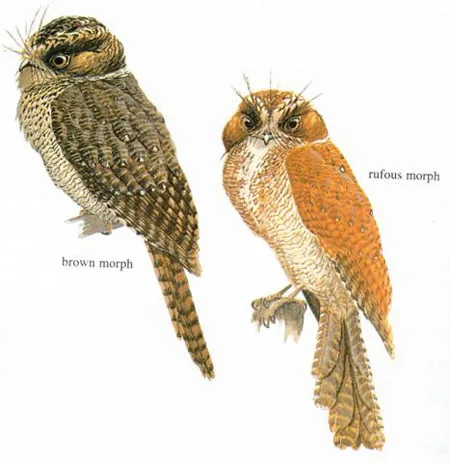
Mountain Owlet-nightjar
[order] APODIFORMES | [family] aegothelidae | [latin] aegotheles albertisi | [UK] Mountain Owlet-nightjar | [FR] aegothele montagnard | [DE] Bergschwalm | [ES] Egotelo Montano | [NL] Bergdwergnachtzwaluw
Subspecies
| Genus | Species | subspecies | Breeding Range | Breeding Range 2 | Non Breeding Range |
| Aegotheles | albertisi | AU | New Guinea | ||
| Aegotheles | albertisi | albertisi | Vokelkop Pen. (nw New Guinea) | ||
| Aegotheles | albertisi | salvadorii | c to se New Guinea | ||
| Aegotheles | albertisi | wondiwoi | Wandammen Pen. (nw New Guinea) |
Physical charateristics
Typical Owlet-Nightjar. Rufous and brown morphs; intermediates also occur. Sexes are similar.
Listen to the sound of Mountain Owlet-nightjar
[audio:http://www.aviflevoland.nl/sounddb/M/Mountain Owlet-nightjar.mp3]
Copyright remark: Most sounds derived from xeno-canto
| wingspan min.: | 0 | cm | wingspan max.: | 0 | cm |
| size min.: | 18 | cm | size max.: | 20 | cm |
| incubation min.: | 0 | days | incubation max.: | 0 | days |
| fledging min.: | 0 | days | fledging max.: | 0 | days |
| broods: | 0 | eggs min.: | 1 | ||
| eggs max.: | 1 |
Range
Australasia : New Guinea
Habitat
Montane forests, extending to edges. Also gardens and tree-fern savannah; found at elevations of 800-3700m.
Reproduction
They nest and roost in holes in trees up to 3.5 m aboce ground. Only two nests were ever found, both containing a single white egg.
Feeding habits
Diet consists of isnects and earhtworm.s Forages at night in the canopy or in clearings of montane porest
Conservation
This species has a very large range, and hence does not approach the thresholds for Vulnerable under the range size criterion (Extent of Occurrence over 20,000 km2 combined with a declining or fluctuating range size, habitat extent/quality, or population size and a small number of locations or severe fragmentation). The population trend appears to be stable, and hence the species does not approach the thresholds for Vulnerable under the population trend criterion (>30% decline over ten years or three generations). The population size has not been quantified, but it is not believed to approach the thresholds for Vulnerable under the population size criterion (over 10,000 mature individuals with a continuing decline estimated to be >10% in ten years or three generations, or with a specified population structure). For these reasons the species is evaluated as Least Concern.

Migration
Presumably sedentary
Distribution map

